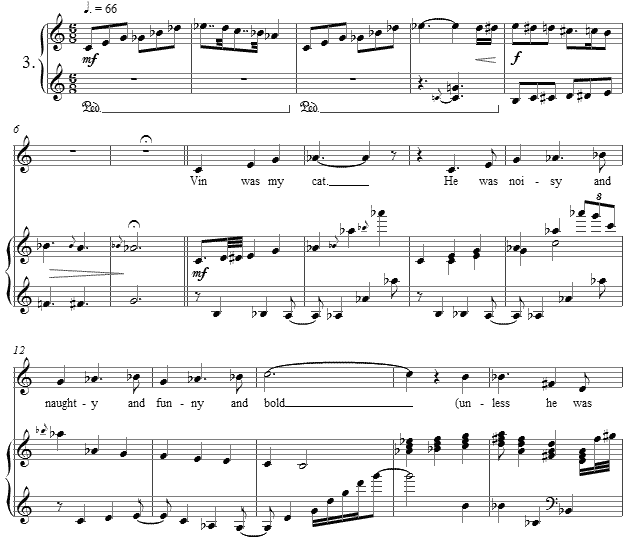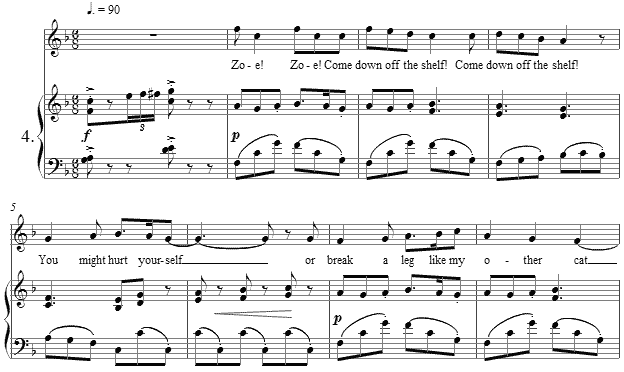Music and Texts of GARY BACHLUND
Vocal Music | Piano | Organ | Chamber Music | Orchestral | Articles and Commentary | Poems and Stories | Miscellany | FAQs
Four Little Cat Songs - (2008)
Julie Dalton Williamson
for medium high voice and piano
for my friend, Jules
i.
Saph goes under the bed
when she's been fed:
perhaps to digest
where darkness is best for these processes.
Or maybe to clean
where she can't be seen.
ii.
Our Ginger Moggy
had eyes that were bright, bright blue.
But then she grew.
And now those eyes are yellow
and they gaze at you as if you're food
which isn't good
if you're cleaning her teeth.
iii.
Vin was my cat.
He was noisy and naughty
and funny
and bold (unless
he was being
a cowardy custard).
Vin sounded all the time
like a squeaky wheel.
I always knew where he was
and where he wasn't.
And now
he isn't.
iv.
Zoe! Zoe!
Come down off the shelf!
You might hurt yourself
or break a leg
like our other cat
who died from that.
Copyright 2008 Julie Dalton Williamson. All international rights reserved. Used with permission.
[ 6 pages, circa 3' 40" ]
Julie Dalton Williamson
Julie Dalton Williamson had edited texts from many biblical sources for the short cycle, From the Song of Songs, during a time when we worked together for Opera New Zealand in Auckland. Over the years since, we have kept in touch, and in 2007 I had a chance to visit her and her husband -- and their cats -- in London. Though I am not a "cat person," a recent message telling of her putting down her cat, Vinnie, touched a chord in me. She had dashed off the text above, Vin Was My Cat, and so I set it as a song for her -- a wee requiem for a cat of my acquaintance. Thereupon she invented other little verses for the other cats as well, which I also set as a little gift to her.
The first setting is a straight-forward hymn like hymn to a cat, yet dealing with that ironic twist of what exactly it is that a cat is "cleaning."
The second setting is a gentle bending of periods, as the first phrase is longer than its answer, all in an "antique" yet straightforward style.
The third setting opens with a polytonal gesture melding C major and its diminished fifth, G flat, resolving melodically through A flat and then a further extension of the gesture. The hexachord, appearing only melodically and in counterpoint stresses the major triad and the natural minor's sixth and seventh degrees. A pivot chord, D augmented, leads easily between tonal regions, and the nominal meter, 6/8, also allows slipping between duple and triple metrical changes without changing meters.
The other tonal regions then include E flat major and minor, as well as the supertonic, as the vocal leans on yet does not settle in any tonal domain except to return to the tonic at the end of the setting, which concludes in an unambiguous C major, suggesting that loss is eventually answered in the sweetness of memories.
For those cat lovers who might be sympathetic and curious, below is a picture of Julie's Vinnie -- Vin for short.
The last setting is an urgent plea to the youngest cat, most acrobatic and worrisome making for any cat lover. Most especially "Jules." The tessitura is the highest of the set to stress the concern of the "speaker."
The score for Four Little Cat Songs is available as a free PDF download, though any major commercial performance or recording of this tiny cycle is prohibited without prior arrangement with the composer and author. Click on the graphic below for this piano-vocal score.
For those who have found themselves at this web page for the sake of their love for and amusement by cats and the sweet humor of Julies Dalton-Williamson, below is offered an addendum. I teased Jules about not mentioning the forbidden topic for many cat lovers -- the litter box. For this, she sent a humorous little dog poem instead, which I quickly set as another song. An encore for the cat songs?
The score for Get That Dog Off My Grass is available as a free PDF download, though any major commercial performance or recording of this tiny cycle is prohibited without prior arrangement with the composer and author. Click on the graphic below for this piano-vocal score.






